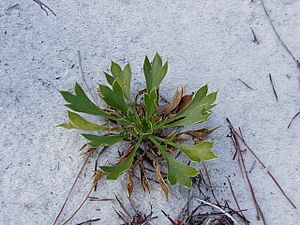Wedgeleaf eryngo facts for kids
Quick facts for kids Wedgeleaf eryngo |
|
|---|---|
 |
|
| Conservation status | |
| Scientific classification | |
| Genus: |
Eryngium
|
| Species: |
cuneifolium
|
The Eryngium cuneifolium is a very rare flowering plant. People call it the wedgeleaf eryngo or snakeroot. It belongs to the carrot family. This special plant is found only in Florida, in a place called Highlands County. It's one of many rare plants that live on the Lake Wales Ridge. This area has many unique plants and animals. In 1987, the United States government listed it as an endangered species. This means it is in danger of disappearing forever.
Contents
What Does This Plant Look Like?
This plant is a perennial herb. This means it's a plant that lives for many years. It can grow from 20 to 66 centimeters tall. That's about the height of a ruler or two. It has a strong, woody taproot that can be over 20 centimeters long. This root helps it get water deep in the ground.
Its Unique Leaves and Flowers
The leaves of the wedgeleaf eryngo are very special. They are shaped like a wedge. Each leaf usually has three pointy tips. The leaves at the bottom of the plant are the biggest. There are also smaller leaves along its tall stem. The whole plant smells nice.
Its flowers grow in a special way. They form dense, head-like clusters. These clusters are part of a larger flower group called a compound umbel. Each tiny flower has five sharp, pointy sepals. Sepals are like small leaves that protect the flower. These sepals make the flower clusters look bristly. The flowers can be white, blue, or greenish. You can see them bloom from July to January. But they bloom the most from August to October.
Where Does the Wedgeleaf Eryngo Live?
This plant lives in a special type of habitat called the Florida scrub. This is a dry area with sandy soil. The wedgeleaf eryngo likes to grow in open spots of white sand. You can find it in gaps between rosemary plants and sand pine trees. It also grows in sandy open areas called blowouts.
Its Sandy Home
The land where it lives is very dry. The open, sunny spots in the scrub are kept clear by natural wildfires. These fires happen every now and then. Other plants that live here include silk bay, scrub palmetto, and eastern prickly pear. Several types of oak trees also grow in this habitat.
Why Is the Wedgeleaf Eryngo Endangered?
There are only 19 known places where this plant grows. All of them are in Highlands County, Florida. Eight of these spots are on protected land. An example is the Lake Wales Ridge Wildlife Area. But the other 11 spots are on private land that is not protected.
Threats to Its Home
The future of these unprotected plants is not certain. Four of these groups of plants are thought to have disappeared from their area. Or they are very close to being destroyed. The remaining areas of Florida scrub, where the snakeroot lives, are in danger. A lot of this land has been used for building homes and for farming. Growing citrus fruits, like oranges, has taken up much of its habitat.
The habitat that is left is broken into smaller pieces. This is called habitat fragmentation. In many areas, even some protected ones, the land is not taken care of properly. This means the natural habitat is not kept healthy.
The Importance of Fire
The Florida scrub is a place where fires happen naturally. Many plants there need fire every few decades to grow well. The snakeroot needs these fires to clear out tall plants and trees. These bigger plants can block the sun that the snakeroot needs. This plant needs wide open spaces to survive. Plants that grow farther from other shrubs do much better.
Stopping fires, which is done to protect buildings, harms this plant. It causes the scrub to become overgrown. This makes it harder for the snakeroot to get enough sun.
How the Wedgeleaf Eryngo Reproduces
This plant also needs fire for its seeds to sprout. Too many dead leaves and lichens on the ground can stop the seeds from growing. After a scrub fire, the snakeroot population grows a lot. Its survival, growth, and ability to make more seeds all get better.
Seeds and Sprouting
During a fire, the adult plant might be destroyed. But the fire helps its soil seed bank get ready to sprout. The soil seed bank is like a hidden store of seeds in the ground. Many new seedlings appear after a fire.
The plant's seeds do not spread very far. Most of them fall to the ground near the parent plant. Also, the scrub rosemary plant might stop the snakeroot seeds from growing. Rosemary produces special chemicals that can stop other plants from growing nearby.
Images for kids



